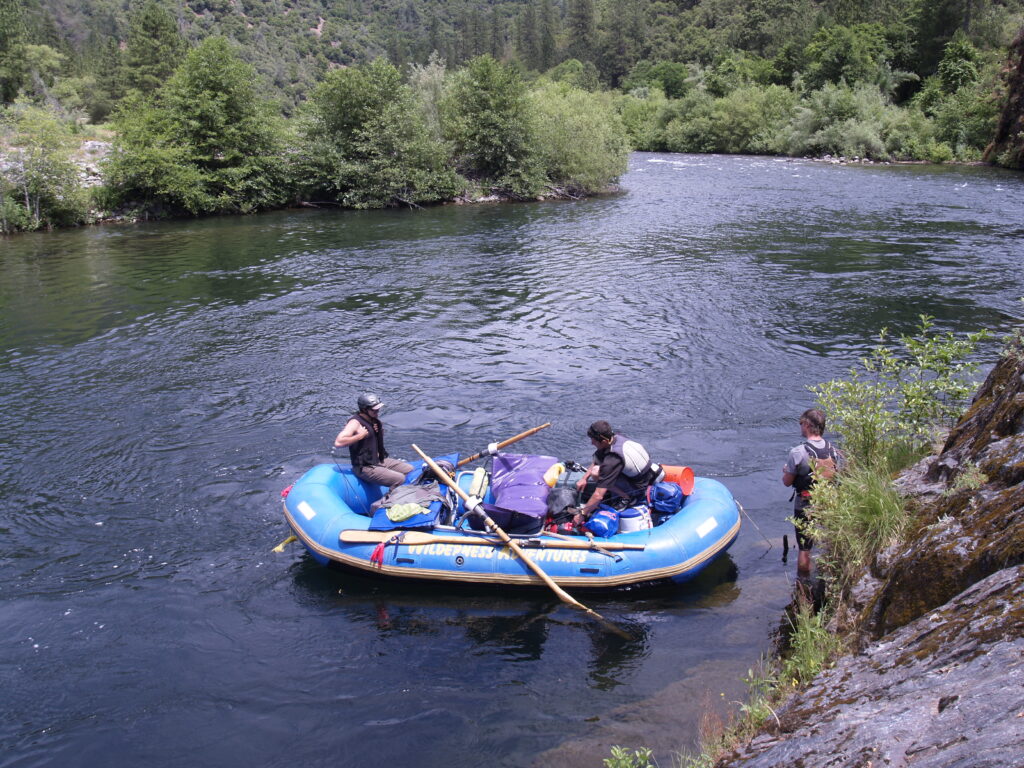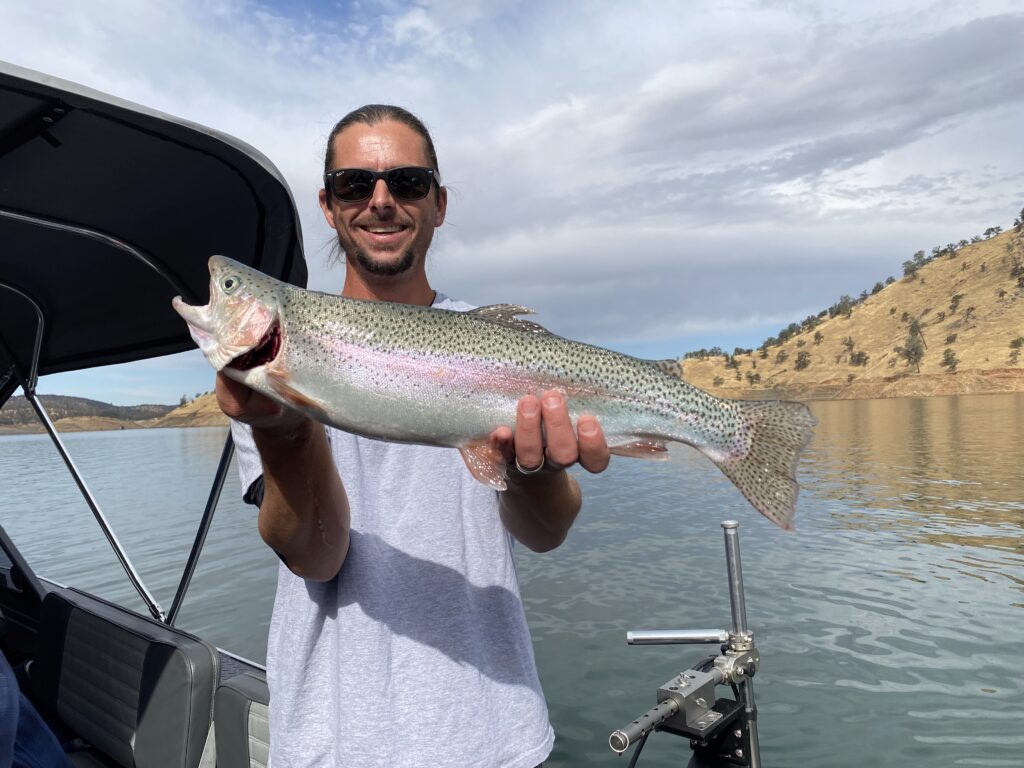Countdown To Trout Opener: Try These Four Outstanding Fisheries

We’re counting down to Saturday’s statewide trout opener with stories from our April issue. Today: A quartet of destinations worth targeting this spring.
By Cal Kellogg
It’s the feeling every angler lives for – that moment when you know another hookup is coming; the time when the fish are feeding with abandon and you’ve got them dialed in.
The big king salmon and 22-inch rainbow bleeding out atop the ice in my cooler were hard evidence of 1) just how effective large 3-inch spoons combined with brisk trolling speeds can be for tempting big trout and landlocked kings and 2) that I was in the zone.
After attaching the rod I’d just landed the rainbow on back to the downrigger, I dropped the
watermelon-pattern spoon down to 34 feet. With the lure back in the zone, I hotfooted it up to the steering wheel and brought the boat around hard.
At first the screen of the sonar unit
was clear, but then a few arches and streaks started showing up. A bit later, a shad ball came into view. The shad were under assault and the sonar screen was littered with arches and jagged lines created by feeding gamefish.
I didn’t see the rod pop off the downrigger, but my wife Gena did. One moment she was sitting down; the next she jumped to her feet and pounced on the bucking rod.
I kicked the boat out of gear and immediately ran to the back to clear the other lines. In situations where the fish are blitzing bait, you never know what you’ll hook. Most likely the fish at the other end of the line will be a trout or king, but it could also be a big bass or even a jumbo channel catfish. I was taking no chances. The last thing we wanted to do was lose a big fish due to a tangle.
From the deep bend in Gena’s rod, I could see that what was on the end of the line was big. As the fight went on and the fish did everything it could to stay deep, I became convinced that it was a hefty brown.
Gena has landed her share of big fish, including a 100-pound tuna, and she fought this trout perfectly, keeping the rod loaded and gaining line when possible. The entire fight probably lasted for about five minutes, but when the thick brown trout finally materialized off the port side, it seemed like the fight had gone on much longer.
“Do you want to keep it or let it go?” I asked.
When Gena opted to release the fish, I swapped my net for some pliers. A quick twist of the wrist and the big brown was free.
How much did Gena’s brown weigh? Certainly more than 5 pounds and perhaps up to 6!
The outstanding action I just described took place at Lake Shasta last spring during the first week of June. While the trout fishing at Shasta is typically very good during the late spring and early summer, it is only one of a long list of California lakes and reservoirs that offer up good to great trout fishing during that seasonal transition.
I love the late-spring trout fishery because it provides maximum options. Most low-elevation lakes are still cool enough during the first part of June to support good trout fishing. And in the mountains, there has typically been enough of a thaw by June to allow anglers to access high-elevation trout waters throughout the Sierra and southern Cascades.
If you’re a Golden State trout angler, you’ve got a lot of great destinations to choose from right now!

SHASTA LAKE
Shasta Lake is truly a magnificent fishery. It sets a high standard against which all other California lakes are measured. Enormous in size, it impounds water from the Sacramento, McCloud and Pit Rivers and is home to several strains of rainbows, plus browns and landlocked king salmon.
May and June are interesting months to visit Shasta because things are in flux. Trout that had been scattered and holding near the surface in April and early May begin to concentrate on schools of small threadfin shad and drop down in the water column with the arrival of warm June weather.
During the month of June, you’ll find plenty of receptive trout holding from 30 to 50 feet deep, but you’ll also encounter much shallower trout scattered from the surface down. This is especially true early and late in the day.
For this reason, you’ll want to stagger your lines from the surface down to about 60 feet, with an emphasis on the middle depths within that range.
Since Shasta trout make a living eating shad, spoons and small plugs are typically winners. Offerings like Needlefish, Excels, Hum Dingers, Kastmasters, and small Rapalas and Lymans all tend to work well. Baitfish-colored lures work best most of the time, and in general you’ll want to troll quickly, from 2 to 3 miles per hour.
Some anglers run with small spoons in order to match the hatch. I often adhere to a big spoon-big fish philosophy, and I tend to do pretty well with spoons that range from 2.5 to 3 inches in length.
Some years it’s Shasta’s rainbows that make the headlines. Other times the lake’s browns make a strong showing. For example, last spring browns were very plentiful and lots of fish up to 6 pounds were caught by trollers pulling hardware.
While Shasta is a huge lake that is home to vast numbers of trout, the lake isn’t known for producing huge fish. Instead, it produces big numbers of very respectably sized trout. The average rainbow caught at Shasta runs 14 to 18 inches, with fish to 5 pounds possible.
Shasta’s browns do tend to grow larger than its rainbows, but they still only top out at around 8 pounds, with a few notable exceptions. In general, the “average” brown goes about 3 pounds, and anything over 5 is considered big.

MIDDLE FORK AMERICAN RIVER
The American River’s Middle Fork bubbles to life high in the Sierra Nevada’s Granite Chief and Desolation Wildernesses. From there the river flows in a roughly westerly direction. The best section for trout fishing, from Oxbow Reservoir to the Middle Fork’s confluence with the North Fork, encompasses about 40 miles. Some parts of this section are easy to access off Highway 49, Forest Hill Road and Mosquito Ridge Road, while other areas require aggressive hiking to reach.
It is hard to believe that the Middle Fork, which isn’t planted and lies little more than an hour’s drive from the state capital in Sacramento and just southeast of Auburn, boasts such a robust population of wild rainbows and browns. Its rainbows are thought to be descendants of the steelhead that ascended the river for eons before the construction of Folsom Dam. The browns are believed to have entered the system after they were planted in the region during the late 1800s, but no one is really sure.

Some of the water from the stretch of the river between French Meadows Dam and Oxbow Reservoir is diverted into a series of tunnels and usedformakinghydroelectricpower. These water diversions make for variable flows below Oxbow. When power generation is underway, the river level rises. When the generators are not working, the river level drops. These fluctuations represent a blessing and a curse for anglers. On one hand, when the flows are up, it disturbs forage items and the trout feed. While high flow periods offer exceptional fishing, anglers, especially those who wade, need to use caution, since flows can rise quickly.
Mayflies, caddisflies, stoneflies, sculpins and crawfish are the primary forage items within the Middle Fork. Unlike many of the state’s wild trout waters, this section of the American is not subject to special regulations. You are welcome to employ flies, bait or lures, barbed hooks and even treble hooks.
I fish the river with both fly and conventional tackle. From the general trout opener in late April through late May, I find spinning gear to be more effective than fly tackle in most cases, but there are exceptions.
When using spinning gear, I utilize a 7-foot fast-action stick rated for 4-to 10-pound line, and team it with a spinning reel loaded with 4- or 6-pound fluorocarbon line for fishing both baits and lures.
My favorite baits are worms, crickets and naturally colored salmon eggs. While trout are plentiful in the Middle Fork, it doesn’t mean they are stupid. For the best results, you must present your bait near the bottom and drift it at the same rate as the current.
To rig up for bait fishing, I’ll tie a No. 14 baitholder hook to the end of my line and place enough split shot 20 inches above the hook to keep the bait drifting naturally among the rocks and gravel. Since different areas of the river vary in depth and rate of flow, you’ll need to add and remove weight frequently to keep the bait drifting properly in the strike zone.
As far as lures go, I like to keep things simple. My entire selection consists of yellow/orange and black/yellow Panther Martins, plus a few small rainbow, gold/black and silver/black Countdown Rapalas. I like to cast these lures directly across the current and allow them to swing back to my side of the river on a tight line before retrieving them slowly and casting again.

LAKE DON PEDRO
Nestled in the Sierra Nevada foothills, Don Pedro offers anglers an exceptional fishing experience. Known for its year-round fishing opportunities, the reservoir is a popular destination for both casual weekend fishermen and serious anglers. While the lake is home to a variety of species, it’s particularly famous for its thriving trout and king salmon populations.
The rainbow trout fishing at Don Pedro is amazing, thanks to both wild fish that spawn in the lake’s tributaries and holdovers from California Department of Fish and Wildlife releases. The lake’s deep, cold waters and the presence of ample forage in the form of threadfin shad create an ideal environment for rainbows to grow large.
This being the case, you’d think Don Pedro would play host to big numbers of anglers, but in truth the reservoir is often overlooked, with nearby New Melones Reservoir drawing much of the regional fishing pressure.
Trolling with spoons is the most effective technique for catching trout at Don Pedro all year long. Speedy Shinersarethemostpopularspoon, but Trigger Spoons, Hum Dingers and Needlefish score well too. Chrome, chrome and blue and black and white/cop car patterns are favorites, but gold, red and copper spoons also draw strikes. In the spring, fishing at depths from the surface to 20 feet works well.
As the surface temperature rises in late spring, the trout will start dropping down in the water column. In the heat of summer, you’ll find them holding as deep as 60 feet, so downriggers are an important tool for chasing Don Pedro rainbows during the warm months.

BASS LAKE
From the middle of the 1960s through the end of the ’70s, Central California’s Bass Lake was the scene of the Hells Angels’ annual Fourth of July run. The notorious event spawned blood-curdling newspaper headlines, restraining orders, curfews and roadblocks. Local vigilantes even patrolled the streets, at times sporting clubs and wearing sidearms.
Time rolls forward and the scene at Bass Lake has changed quite a bit over the past 50 years. By the early 1980s, the Angels had all but disappeared, replaced by big numbers of tourists, boaters and anglers. These days, the lake is known as one of the region’s premiere trout fishing destinations.
Bass is situated in the Sierra National Forest in Madera County, about 14 miles from the southern entrance to Yosemite National Park. The lake was formed in 1910 when the 145-foot Crane Valley Dam was constructed by PG&E to impound the waters of Willow Creek, a tributary of the San Joaquin River.
Bass Lake is relatively small, with only 14 miles of shoreline, a length of 4 miles and a maximum depth of 98 feet. Located very near the geographic center of the state, the lion’s share of visitors are from Southern and Central California, but there is a loyal constituency of NorCal anglers who make the trek south to fish the lake’s rich waters.
Set at an elevation of 3,376 feet, the lake features both coldwater fish in the form of rainbow trout and kokanee salmon, as well as warmwater species such as spotted bass, largemouth bass, crappie and catfish.
Bass Lake is heavily stocked with rainbows that average 13 inches and range up to 24 inches and 5 pounds. The lake produces some of the largest kokanee in California too. The average fish runs 16 to 17 inches, but fish over 20 inches have been common for the past several years.
In early summer, both trolling and bank fishing account for hefty stringers of rainbows for Bass Lake anglers. The favorite offering among trollers is either a small dodger or a set of micro flashers trailing a threaded nightcrawler or an artificial Berkley Gulp! Crawler trolled 1 to 1.5 mph.
Bankers do best with floating dough baits such as PowerBait and Zeke’s Sierra Gold in a variety of different colors. Inflated worms can pay hefty dividends too. CS



